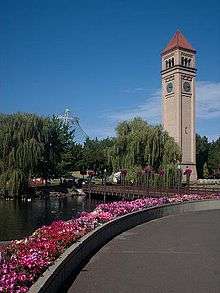Expo '74
| EXPO Spokane 1974 | |
|---|---|
 The Expo '74 logo design, based on the Möbius strip. | |
| Overview | |
| BIE-class | Specialized exposition |
| Name | Expo '74 |
| Motto | Progress without pollution |
| Area | 40.5 hectares (100 acres) |
| Visitors | 1,500,000 |
| Participant(s) | |
| Countries | 10 |
| Location | |
| Country | United States |
| City | Spokane |
| Venue | Crystal Island (renamed "Canada Island" when it was officially deeded to Canada and used to host the British Columbia pavilion), Havermale Island, and the adjacent north and south banks of the Spokane River |
| Coordinates | 47°39′43.9″N 117°25′8.4″W / 47.662194°N 117.419000°W |
| Timeline | |
| Opening | May 4, 1974 |
| Closure | November 3, 1974 |
| Specialized expositions | |
| Previous | Expo 71 in Budapest |
| Next | Expo '75 in Okinawa |
| Universal expositions | |
| Previous | Expo '70 in Osaka |
| Next | Seville Expo '92 in Seville |
| Horticultural expositions | |
| Previous | Internationale Gartenbauausstellung 73 in Hamburg |
| Next | Floralies Internationales de Montréal in Montreal |
| Simultaneous | |
| Horticultural (AIPH) | Wiener Internationale Gartenschau 74 |
Expo '74 was the first environmentally themed world's fair. It was held in Spokane, Washington, United States and ran from 4 May to 3 November 1974. The heart of the fair park grounds was located on Canada Island, Havermale Island, and the adjacent south bank of the Spokane River in the center of the city. With the exception of two pavilions, all of the major buildings were modular structures assembled on the site. The fair had 5.2 million visitors and was considered a success, nearly breaking even, revitalizing the blighted urban core, and pumping an estimated $150 million into the local economy and surrounding region.
In proclaiming itself the first exposition on an environmental theme, Expo '74 distanced itself from the more techno-centric world's fairs of the 1960s. The environmental theme was promoted in several high-profile events, such as a symposium on United Nations World Environment Day (June 5) attended by more than 1,200 people including many international representatives, and ECAFE Day for the United Nations Economic Council for Asia and the Far East (June 14) that discussed regional environment issues.[1]
Background

Spokane was the smallest city to host a world's fair recognized by the Bureau of International Expositions until Knoxville, Tennessee held the 1982 World's Fair eight years later. World's Fairs began at the beginning of the Industrial Revolution as public showcases. Expo '74 was the first fair in decades that did not focus on the space age, futuristic themes, or utopian ideas of living. An environmental theme was decided upon by the organizing committee, however there was some uncertainty about it because it had never been used previously by a World's Fair to that time. After considering several other slogans, such as "How Man Can Live, Work and Play in Harmony With His Environment", Expo '74 settled on "Celebrating Tomorrow's Fresh New Environment."[2]

Uncertainty about the ability of a city the modest size of Spokane to create a successful event caused many nations and corporations to hesitate about making major investments in the fair. Kodak, General Motors, and Ford hosted pavilions at this fair but they were scaled down in size and presence compared to the exhibits constructed for the New York Worlds Fair ten years earlier. For the first time since the company's beginning, General Electric did not have a fair pavilion but it sponsored the musical group Up with People that performed during the summer at the fair. Pacific Northwest Bell had a pavilion that eliminated the use of air conditioning by using louvered panels on the roof. They demonstrated the use of TTY equipment and discussed the use of 911 for emergency telephone services. Expo '74 was the last time that the Bell system would exhibit at a world's fair before its breakup ten years later.

Nations with an official presence at the fair included Australia, Canada, West Germany, Iran, Japan, Taiwan, Republic of Korea, United States and the USSR.[1] Architectural critics were intrigued by the Australian Pavilion with its 36 screen revolving audio visual platform and a model of the newly completed Sydney Opera House. (The artistic director for the project was film director Jonathan Dawson). However, writer Calvin Trillin tartly commented that the exhibits of several other countries seemed designed to demonstrate their nation's lack of environmental care. "While other world's fairs had introduced the telephone, the escalator, and the Belgian waffle, Spokane's Expo '74 would be associated forever with the 'institutionalized mea culpa,'" Trillin wrote in The New Yorker.[2]
President Richard M. Nixon presided over the fair's opening ceremony where he addressed a crowd of some 85,000, including a few hecklers who shouted "Jail to the Chief!". However, by the time the fair closed, Nixon had already resigned in shame due to the Watergate Scandal.[3]
One piece of technology that made its debut at Expo '74 was the IMAX movie theater. The original theater, built inside of the United States Pavilion, had a screen that measured 90 ft × 65 ft (27 m × 20 m), completely covering the front wall of the pavilion. It was the largest indoor movie screen at the time and had bigger dimension than a typical drive-in movie screen. 'The quote, "The Earth does not belong to Man, Man belongs to the Earth" (attributed to Chief Seattle) was written in large letters on the outside wall. Inside the pavilion, visitors watched "Man Belongs to the Earth," a 23-minute IMAX film made for Expo by Paramount. Scenes of U.S. splendor led into environmental problems including air pollution in Denver. The film was so realistic—especially during a sequence flying through the Grand Canyon—that motion sickness bags had to be made available.' [4]
The fair also featured the interactive movie system Kinoautomat.

After the event closed, the exposition site became the city's 100 acre (400,000 m²) Riverfront Park, containing the former U.S. Pavilion and a clock tower (part of a Great Northern rail depot that was demolished for Expo '74), which prominently featured the park's logo.
Several structures built for the fair are still standing. The United States Pavilion still houses an IMAX theater built after the fair (The original one built for the fair beneath the pavilion was abandoned), as well as a winter ice rink that is put to other varied uses in the warm months. The Washington State Pavilion still stands and is used as the Spokane Convention Center and the INB Performing Arts Center. The Carousel remains a popular attraction. It originated in Natatorium Park, which closed in 1967, and was restored for the World's Fair.[5]
The original covering of the US pavilion was a thick vinyl sheeting that was not designed to last. It was allowed to remain until it began to deteriorate, become unsightly and was thought a safety hazard. When the city opted to remove the covering, chunks of the thick vinyl could be purchased as keep-sakes. The tent design itself with its heavy cables was not intended to stay up, however the people of Spokane voiced the opinion that it should remain as a unique architectural statement, and a monument to the 1974 exposition.
Souvenirs are still available at The White Elephant in Spokane.
Entertainment and famous visitors
Dance: Cheremosh Ukrainian Dance Company
See also
- Expo '74, special Amtrak service between Spokane and Seattle
- List of world expositions
- List of world's fairs
References
- 1 2 Bowers, Dawn (1974). Expo '74 World's Fair Spokane: Official Commemorative of the Spokane World Exposition 1974. Expo '74 Corporation.
- 1 2 William T. Youngs (April 21, 2010). "Expo '74 and Earth Day". The Pacific Northwest Inlander. Spokane, WA, USA: The Pacific NW Inlander. Retrieved 26 May 2011.
- ↑ http://www.historylink.org/index.cfm?DisplayPage=output.cfm&file_id=5133
- ↑ https://archive.org/details/govntis.ava03671vnb1
- ↑ Spokane's Natatorium Park - Home Page
External links
| Wikimedia Commons has media related to Expo '74. |
- Spokane Expo '74
- A Virtual Visit to Expo '74
- Spokane Night Scenes, Riverfront Park
- Riverfront Park: Still an attraction 30 years after fair